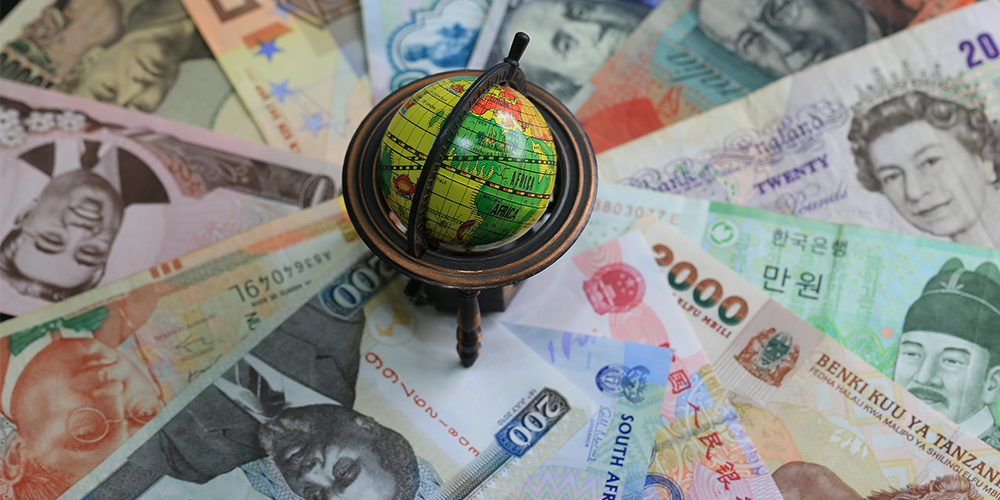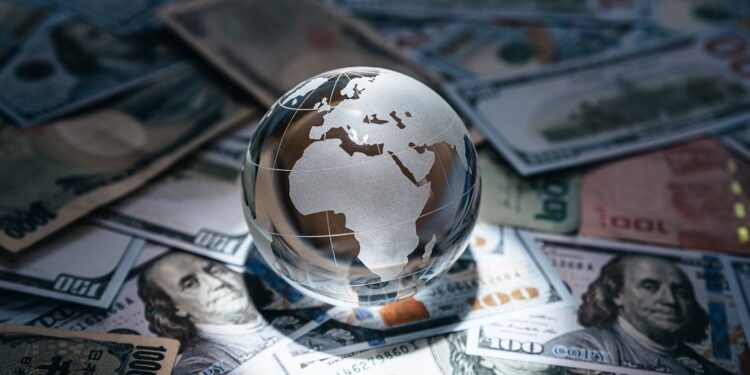Echoes of the Past

To understand where the global economy is headed, we must first acknowledge the profound impact of recent historical events. The early 2020s were characterized by unprecedented disruptions that continue to reverberate.
A. The Pandemic’s Lasting Scars and Surprising Resilience
The COVID-19 pandemic triggered the deepest global recession since World War II, fundamentally altering supply chains, labor markets, and consumer behavior.
A. Supply Chain Disruptions: Widespread lockdowns and shifts in demand exposed the fragility of global supply chains. Factories halted production, shipping costs skyrocketed, and just-in-time inventory systems buckled. While many kinks have been worked out, a push for reshoring and friend-shoring (moving production closer to home or to politically aligned countries) continues to gain momentum, emphasizing resilience over pure efficiency.
B. Labor Market Shifts: The “Great Resignation” and the rise of remote work fundamentally reshaped how and where people work. This has led to persistent labor shortages in some sectors, wage inflation pressures, and a re-evaluation of work-life balance by millions, affecting productivity and employment dynamics across various industries.
C. Fiscal and Monetary Stimulus: Governments and central banks unleashed massive fiscal and monetary stimulus packages to avert economic collapse. While preventing a deeper crisis, these measures injected unprecedented liquidity, contributing significantly to the inflationary pressures observed globally in the years that followed.
D. Digital Acceleration: The pandemic forced rapid adoption of digital technologies for work, education, commerce, and healthcare. This accelerated digitalization continues to drive innovation and create new economic sectors, fundamentally changing how businesses operate and consumers interact with the economy.
B. Inflationary Pressures and Central Bank Responses
Following the pandemic, a surge in inflation caught many by surprise, driven by a confluence of factors.
A. Demand-Side Factors: Pent-up consumer demand from lockdowns, coupled with substantial fiscal stimulus, boosted aggregate demand beyond pre-pandemic levels.
B. Supply-Side Factors: Ongoing supply chain issues, rising energy prices (exacerbated by geopolitical events), and labor shortages constrained supply, pushing prices higher.
C. Geopolitical Shocks: The conflict in Ukraine in early 2022 sent shockwaves through commodity markets, particularly for energy and food, adding further inflationary pressure and disrupting trade routes.
D. Aggressive Monetary Tightening: In response, major central banks, led by the U.S. Federal Reserve, embarked on the most aggressive interest rate hiking cycle in decades. This aimed to cool inflation by reducing demand, but it also increased borrowing costs for businesses and consumers, raising fears of a global recession. The pace and scale of these hikes had significant ripple effects on currency markets and capital flows, especially impacting emerging economies.
Key Drivers of the Global Economy’s Next Moves
Looking ahead, several powerful forces are set to dictate the trajectory of the global economy.
A. Geopolitical Realignment and Fragmented Trade
The post-Cold War era of increasing globalization is giving way to a more fragmented and multi-polar world.
A. U.S.-China Relations: The strategic rivalry between the United States and China remains a dominant theme. This includes trade disputes, technology restrictions (e.g., semiconductors), and competition for influence in emerging markets. This rivalry often forces other nations to choose sides or navigate a complex geopolitical tightrope, impacting global supply chains and investment flows.
B. Regional Blocs and Bilateral Agreements: There’s a growing emphasis on strengthening regional trade blocs (e.g., ASEAN, EU) and forging bilateral agreements, sometimes at the expense of multilateral institutions like the WTO. This could lead to more localized supply chains and different standards across regions.
C. Resource Nationalism: Countries with abundant natural resources (e.g., critical minerals, energy) are increasingly asserting control over these assets, often leading to export restrictions or preferential trade agreements, impacting global commodity markets and industrial production.
D. Impact on Foreign Direct Investment (FDI): Geopolitical tensions can redirect FDI flows, with companies becoming more cautious about investing in politically sensitive regions or diversifying their manufacturing bases to mitigate risk.
B. Technological Acceleration and AI Integration
The pace of technological change continues to accelerate, with Artificial Intelligence (AI) at the forefront of the next wave of economic transformation.
A. Artificial Intelligence (AI): AI is moving beyond niche applications to fundamentally reshape industries.
A. Productivity Gains: AI promises to boost productivity across sectors through automation, enhanced decision-making, and optimized resource allocation. This could lead to significant economic growth, though the timing and distribution of these gains are uncertain.
B. Job Market Disruption: While AI will create new jobs, it will also automate many existing tasks, leading to potential job displacement and requiring significant investment in reskilling and upskilling the workforce. Policy responses to manage this transition will be crucial.
C. Innovation Hubs: Nations and regions that lead in AI research, development, and deployment are likely to gain a significant economic advantage, fostering new industries and attracting talent.
B. Quantum Computing: Though still nascent, quantum computing holds the potential to revolutionize fields like drug discovery, material science, and financial modeling, offering exponential increases in computational power for specific problems. Its long-term economic impact could be immense.
C. Biotechnology and Life Sciences: Advances in genomics, personalized medicine, and synthetic biology are creating new industries and addressing global health challenges, with significant economic implications for healthcare, agriculture, and manufacturing.
D. Clean Energy Technologies: The push for decarbonization is driving massive investment and innovation in renewable energy (solar, wind), battery storage, green hydrogen, and carbon capture technologies. This transition presents significant economic opportunities and challenges for traditional energy sectors.
C. Demographic Shifts and Workforce Evolution
Global demographics are undergoing profound changes that will reshape labor markets, consumption patterns, and social welfare systems.
A. Aging Populations: Many developed nations and increasingly some developing ones (e.g., China) face rapidly aging populations. This leads to higher healthcare and pension costs, potential labor shortages, and shifts in consumption patterns (e.g., greater demand for senior care products and services).
B. Youth Bulges: Conversely, some regions, particularly in Sub-Saharan Africa, have large youth populations. While offering a demographic dividend (a large working-age population), this requires massive investment in education, job creation, and infrastructure to prevent social instability.
C. Migration Patterns: Geopolitical events, climate change, and economic disparities continue to drive global migration, impacting labor supply, cultural diversity, and social integration in host countries.
D. Skills Gap: The rapid pace of technological change is exacerbating the skills gap, with many workers lacking the competencies required for future jobs. Lifelong learning, vocational training, and adaptive education systems will be crucial for economic competitiveness.
D. Climate Change and the Green Transition
The accelerating impacts of climate change are not just environmental issues; they are profound economic challenges and opportunities.
A. Physical Risks: Extreme weather events (floods, droughts, heatwaves) cause immense economic damage, disrupt supply chains, and impact agricultural productivity, leading to rising insurance costs and infrastructure investment needs.
B. Transition Risks: The shift away from fossil fuels creates risks for carbon-intensive industries (e.g., stranded assets) but also massive opportunities in renewable energy, green finance, and sustainable technologies.
C. Carbon Pricing and Regulation: More countries are implementing carbon taxes, cap-and-trade systems, and stringent environmental regulations, which will reshape industrial processes and incentivize green investments. This could create new trade barriers or competitive advantages.
D. Green Investment Boom: Trillions of dollars are being directed towards the green transition, spurring innovation, creating jobs, and driving investment in sustainable infrastructure and technologies. This forms a significant new economic sector.
Anticipating the Next Economic Moves

Given these drivers, several “next moves” or scenarios for the global economy appear plausible.
A. Continued Disinflation and Soft Landing (Optimistic Scenario)
In this scenario, central banks successfully bring inflation down to target levels without triggering a severe recession.
A. Gradual Interest Rate Cuts: As inflation cools, central banks might begin to cautiously cut interest rates, easing financial conditions and supporting economic growth.
B. Resilient Labor Markets: Despite some softening, labor markets remain relatively strong, supporting consumer spending.
C. Supply Chain Normalization: Further normalization of global supply chains helps reduce cost pressures.
D. Implications: Sustained but moderate global growth, renewed confidence in financial markets, and a more stable environment for business investment.
B. Stubborn Inflation and Hard Landing (Pessimistic Scenario)
This scenario sees inflation proving more persistent, forcing central banks to maintain higher interest rates for longer or even resume hikes, leading to a deeper downturn.
A. Higher-for-Longer Rates: Interest rates remain elevated, increasing borrowing costs for governments, businesses, and consumers, potentially leading to debt distress in vulnerable countries.
B. Recessionary Pressures: High rates stifle investment and consumption, leading to widespread corporate bankruptcies, job losses, and a significant global economic slowdown or recession.
C. Debt Crises: Emerging markets with dollar-denominated debt could face severe crises due to a strong dollar and high interest rates.
D. Implications: Increased unemployment, financial market instability, reduced trade, and potential social unrest in some regions.
C. Geo-Economic Fragmentation and Resilient Regionalization
This scenario emphasizes the ongoing shift away from hyper-globalization towards more regionalized and secure supply chains.
A. Trade Divergence: Diverging trade policies and standards between major economic blocs (e.g., U.S./Europe vs. China-aligned countries) create inefficiencies but also boost domestic and regional production.
B. Investment Reallocation: FDI shifts towards politically stable and strategically aligned regions, potentially leading to uneven economic development.
C. Dual Supply Chains: Companies build redundant or “dual” supply chains to mitigate geopolitical risks, increasing costs but enhancing resilience.
D. Implications: Slower overall global growth but potentially more stable regional growth, increased focus on domestic capabilities, and possibly higher consumer prices due to less efficient global production.
D. AI-Driven Productivity Surge (Long-Term Transformative Scenario)
While likely a longer-term trend, AI’s potential could redefine economic growth.
A. Unprecedented Productivity Gains: If AI leads to significant breakthroughs in automation and efficiency across multiple sectors, it could trigger a new era of robust economic growth.
B. Job Market Restructuring: Requires massive investment in education and retraining to ensure a just transition for displaced workers.
C. “Superstar” Firms: Companies and nations that master AI deployment could achieve dominant market positions, potentially increasing economic inequality if benefits aren’t widely distributed.
D. Implications: Potentially very high economic growth rates, but also profound societal changes, requiring new policy frameworks for social safety nets and wealth distribution.
Strategic Implications for Different Stakeholders
The anticipated next moves of the global economy carry distinct implications for various actors.
A. For Governments and Policymakers
A. Fiscal Prudence: Managing high public debt levels (accumulated during the pandemic) while investing in critical areas (AI, green transition, education) will be a balancing act.
B. Supply Chain Resilience: Actively promoting friend-shoring and reshoring, diversifying critical material sources, and investing in domestic manufacturing capabilities.
C. Regulatory Adaptation: Developing agile regulatory frameworks for emerging technologies like AI, balancing innovation with safety, ethics, and competition.
D. Social Safety Nets: Strengthening social protection systems and investing in lifelong learning to manage job market transitions and demographic shifts.
E. International Cooperation: Despite fragmentation, fostering cooperation on global challenges like climate change, pandemic preparedness, and cybersecurity remains critical.
B. For Businesses and Corporations
A. Diversify Supply Chains: Reduce over-reliance on single regions or suppliers to build greater resilience against geopolitical shocks.
B. Invest in AI and Digital Transformation: Integrate AI into operations to enhance productivity, optimize processes, and drive innovation. This includes investing in employee training.
C. Focus on Sustainability: Align business models with the green transition, as regulatory pressures and consumer demand for sustainable products will only grow.
D. Talent Management: Attract, retain, and reskill talent to adapt to evolving labor market demands and technological shifts.
E. Agility and Adaptation: The ability to quickly pivot strategies and business models in response to rapid global changes will be a key differentiator.
C. For Investors
A. Diversification: Maintain a diversified portfolio across geographies, asset classes, and industries to mitigate risks from market volatility and geopolitical fragmentation.
B. Focus on Quality: Invest in companies with strong fundamentals, healthy balance sheets, pricing power, and clear competitive advantages.
C. Thematic Investing: Consider thematic investments in areas poised for long-term growth, such as AI, clean energy, cybersecurity, and advanced healthcare.
D. Monitor Geopolitical Risks: Stay informed about geopolitical developments as they can rapidly impact market sentiment and specific sectors.
E. Inflation Hedging: Consider assets that perform well during inflationary periods, such as real estate, commodities, or inflation-protected securities.
D. For Individuals
A. Financial Literacy: Enhance your understanding of personal finance, including budgeting, saving, and investing, to navigate economic uncertainties.
B. Skills Development: Continuously invest in your own skills and education to remain competitive in a rapidly evolving job market, particularly in areas related to technology and human-centric roles.
C. Build an Emergency Fund: A robust emergency fund remains essential to weather unexpected job losses or economic downturns.
D. Diversify Income Streams: Consider side hustles or developing multiple income sources to build financial resilience.
E. Long-Term Perspective: For long-term goals like retirement, maintain a consistent investment strategy and avoid emotional decisions driven by short-term market fluctuations.
Conclusion
The global economy is undeniably at a pivotal juncture, moving through a period of significant recalibration following the unprecedented disruptions of the early 2020s. The interplay of geopolitical shifts, technological revolutions (especially AI), demographic transformations, and the urgent imperative of climate action will define its next moves. While challenges such as persistent inflation, geopolitical fragmentation, and job market transitions loom large, the opportunities for innovation, sustainable growth, and the creation of new industries are equally vast. Navigating this dynamic landscape successfully will require adaptability, strategic foresight, and a commitment to continuous learning from all stakeholders. Understanding these intricate forces is not just an academic exercise; it’s a vital step towards positioning ourselves for resilience and prosperity in the evolving global economic order.













